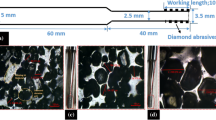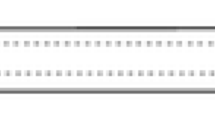Abstract
The strength between the cortical screw and bone following an orthopaedic implant surgery is an important determinant for the success of osteosynthesis. An excessive axial cutting force during drilling produces microcracks in the bone surface, resulting in reduced strength between the screw and bone, resulting in loosening of implant. The present work, investigates the influence of drilling parameters on microcracks generated in the drilled surface and pull-out strength of screw fixed in cortical bone of human tibia. The holes were drilled by two different techniques: conventional surgical bone drilling (CSBD) and rotary ultrasonic bone drilling (RUBD), by a recently developed operation theatre (OT) compatible machine. Cutting force generated in drilling of human tibia using RUBD was 30–40% lesser than that of CSBD. Scanning electron microscopy (SEM) also revealed that RUBD produced significantly lesser and thinner microcracks than that of CSBD in human bones. Biomechanical pull-out test results showed that, the pull-out strength of screws inserted into drilled holes by RUBD was much higher (100–150%) than that of CSBD. A significant difference in pull-out strength (p < 0.05) between RUBD and CSBD was revealed by statistical analysis at 95% confidence interval.








Similar content being viewed by others
References
Alam, K., E. Hassan, and I. Bahadur. Experimental measurements of temperatures in ultrasonically assisted drilling of cortical bone. Biotechnol. Biotechnol. Equip. 29:753–757, 2015.
Alam, K., A. V. Mitrofanov, and V. V. Silberschmidt. Measurements of surface roughness in conventional and ultrasonically assisted bone drilling. Am. J. Biomed. Sci. 2009. https://doi.org/10.5099/aj090400312.
Alam, K., A. V. Mitrofanov, and V. V. Silberschmidt. Experimental investigations of forces and torque in conventional and ultrasonically-assisted drilling of cortical bone. Med. Eng. Phys. 33:234–239, 2011.
Augustin, G., S. Davila, K. Mihoci, T. Udiljak, D. S. Vedrina, and A. Antabak. Thermal osteonecrosis and bone drilling parameters revisited. Arch. Orthop. Trauma Surg. 128:71–77, 2008.
Behiri, J. C., and W. Bonfield. Crack growth resistance in cortical bone: concept of microcrack toughening. J. Biomech. 30:763–769, 1995.
Bertollo, N., H. R. M. Milne, L. P. Ellis, P. C. Stephens, R. M. Gillies, and W. R. Walsh. A comparison of the thermal properties of 2- and 3-fluted drills and the effects on bone cell viability and screw pull-out strength in an ovine model. Clin. Biomech. 25:613–617, 2010.
Brien, F. J. O., D. Taylor, and T. C. Lee. The effect of bone microstructure on the initiation and growth of microcracks. J. Orthop. Res. 23:475–480, 2005.
Burr, D. B., C. H. Turner, P. Naick, M. R. Forwood, W. Ambrosius, M. S. Hasan, and R. Pidaparti. Does microdamage accumulation affect the mechanical properties of bone ? J. Biomech. 31:337–345, 1998.
Chen, L., C. Tai, P. Lai, D. Lee, T. Tsai, T. Fu, C. Niu, and W. Chen. Pullout strength for cannulated pedicle screws with bone cement augmentation in severely osteoporotic bone : influences of radial hole and pilot hole tapping. Clin. Biomech. 24:613–618, 2009.
Gupta, V., and P. M. Pandey. An in-vitro study of cutting force and torque during rotary ultrasonic bone drilling. Proc. Inst. Mech. Eng. Part B J. Eng. Manuf. 232:1549–1560, 2018.
Gupta, V., P. M. Pandey, and V. V. Silberschmidt. Rotary ultrasonic bone drilling : improved pullout strength and reduced damage. Med. Eng. Phys. 41:1–8, 2017.
Gupta, V., R. P. Singh, P. M. Pandey, and R. Gupta. In vitro comparison of conventional surgical and rotary ultrasonic bone drilling techniques. Proc. Inst. Mech. Eng. Part H J. Eng. Med. 234:398–411, 2020.
Hillery, M. T., and I. Shuaib. Temperature effects in the drilling of human and bovine bone. J. Mater. Process. Technol. 92–93:302–308, 1999.
Hillier, M. L., and L. S. Bell. Differentiating human bone from animal bone: a review of histological methods. J. Forensic Sci. 52:249–263, 2007.
Hou, Y., C. Li, H. Ma, Y. Zhang, M. Yang, and X. Zhang. An experimental research on bone drilling temperature in orthopaedic surgery. Open Mater. Sci. J. 9:178–188, 2015.
Hsu, C., C. Chao, J. Wang, S. Hou, Y. Tsai, and J. Lin. Increase of pullout strength of spinal pedicle screws with conical core: biomechanical tests and finite element analyses. J. Orthop. Res. 23:788–794, 2005.
Kim, Y., W. Choi, and K. Rhyu. Assessment of pedicle screw pullout strength based on various screw designs and bone densities—an ex vivo biomechanical study. Spine J. 12:164–168, 2012.
Li, X., Y. Huang, L. Zheng, H. Liu, X. Niu, J. Huang, F. Zhao, and Y. Fan. Effect of substrate stiffness on the functions of rat bone marrow and adipose tissue derived mesenchymal stem cells in vitro. J. Biomed. Mater. Res. A 102A:1092–1101, 2013.
Li, X., Y. Yang, Y. Fan, Q. Feng, F. Z. Cui, and F. Watari. Biocomposites reinforced by fibers or tubes as scaffolds for tissue engineering or regenerative medicine. J. Biomed. Mater. Res. Part A 102:1580–1594, 2014.
Lill, C. A., E. Schneider, J. Goldhahn, A. Haslemann, and F. Zeifang. Mechanical performance of cylindrical and dual core pedicle screws in calf and human vertebrae. Arch. Orthop. Trauma Surg. 126:686–694, 2006.
MacAvelia, T., M. Salahi, M. Olsen, M. Crookshank, E. H. Schemitsch, A. Ghasempoor, F. Janabi-Sharifi, and R. Zdero. Biomechanical measurements of surgical drilling force and torque in human versus artificial femurs. J. Biomech. Eng. 134:124503, 2012.
Ono, A., M. D. Brown, L. L. Latta, E. L. Milne, and D. C. Holmes. Triangulated pedicle screw construct technique and pull-out strength of conical and cylindrical screws. J. Spinal Disord. 14:323–329, 2001.
Singh, G., V. Jain, and D. Gupta. Comparative study for surface topography of bone drilling using conventional drilling and loose abrasive machining. Proc. IMechE Part H J. Eng. Med. 229:225–231, 2015.
Singh, R. P., P. M. Pandey, C. Behera, and A. R. Mridha. Effects of rotary ultrasonic bone drilling on cutting force and temperature in the human bones. Proc: Inst. Mech. Eng. Part H J. Eng. Med., 2020. https://doi.org/10.1177/0954411919889913.
Singh, R. P., P. M. Pandey, and A. R. Mridha. An in-vitro study of temperature rise during rotary ultrasonic bone drilling of human bone. Med. Eng. Phys. 79:33–43, 2020.
Singh, R. P., P. M. Pandey, A. R. Mridha, and T. Joshi. Experimental investigations and statistical modeling of cutting force and torque in rotary ultrasonic bone drilling of human cadaver bone. Proc. IMechE Part H J. Eng. Med. 234:148–162, 2020.
Soriano, J., A. Garay, P. Aristimuño, L. M. Iriarte, J. A. Eguren, and P. J. Arrazola. Effects of rotational speed, feed rate and tool type on temperatures and cutting forces when drilling bovine cortical bone. Mach. Sci. Technol. 17:611–636, 2013.
Stefan, U., B. Michael, and S. Werner. Effects of three different preservation methods on the mechanical properties of human and bovine cortical bone. Bone 47:1048–1053, 2010.
Tsai, W., P. Chen, T. Lu, S. Wu, S. Shih, and S. Lin. Comparison and prediction of pullout strength of conical and cylindrical pedicle screws within synthetic bone. BMC Musculoskelet. Disord. 9:1–9, 2009.
Udiljak, T., D. Ciglar, and S. Skoric. Investigation into bone drilling and thermal bone necrosis. J. Med. Biomed. Res. 2:103–112, 2007.
Wang, Y., M. Cao, Y. Zhao, G. Zhou, W. Liu, and D. Li. Experimental investigations on microcracks in vibrational and conventional drilling of cortical bone. J. Nanomater. 1–5:2013, 2013.
Yuan, A., W. Wang, Y. Shi, N. Yang, and X. Yuan. Experimental analysis of drilling process in cortical bone. Med. Eng. Phys. 36:261–266, 2016.
Funding
This work was supported by the Society for Research and Initiatives for Sustainable Technologies—SRISTI (Sanction No.: MOU BET. IITD AND SRISTI), Ahmedabad, Gujarat.
Conflict of interest
None.
Ethical Approval
Ethical approval was received from both Institute ethics committee (IEC) AIIMS Ref No: IEC-273/01.06.2018, RP-32/2018 and from IEC IITD Ref No: Ethics Application P-024.
Author information
Authors and Affiliations
Corresponding author
Additional information
Associate Editor Kent Leach oversaw the review of this article.
Publisher's Note
Springer Nature remains neutral with regard to jurisdictional claims in published maps and institutional affiliations.
Rights and permissions
About this article
Cite this article
Singh, R.P., Gupta, V., Pandey, P.M. et al. Effect of Drilling Techniques on Microcracks and Pull-Out Strength of Cortical Screw Fixed in Human Tibia: An In-Vitro Study. Ann Biomed Eng 49, 382–393 (2021). https://doi.org/10.1007/s10439-020-02565-2
Received:
Accepted:
Published:
Issue Date:
DOI: https://doi.org/10.1007/s10439-020-02565-2




